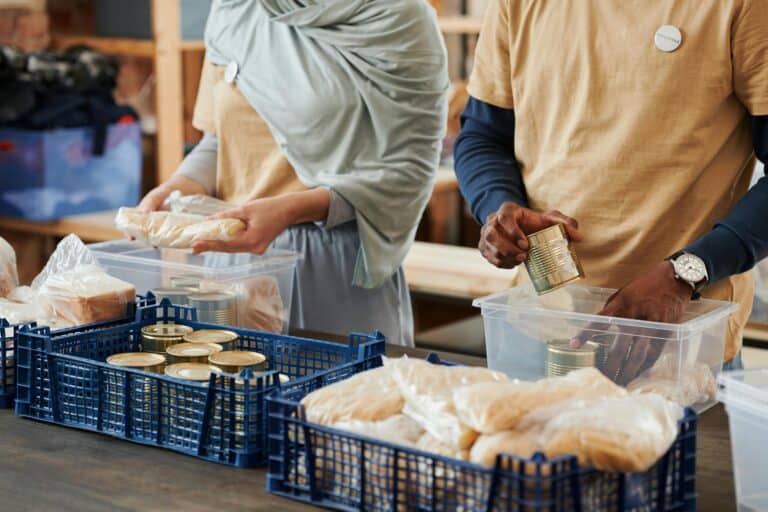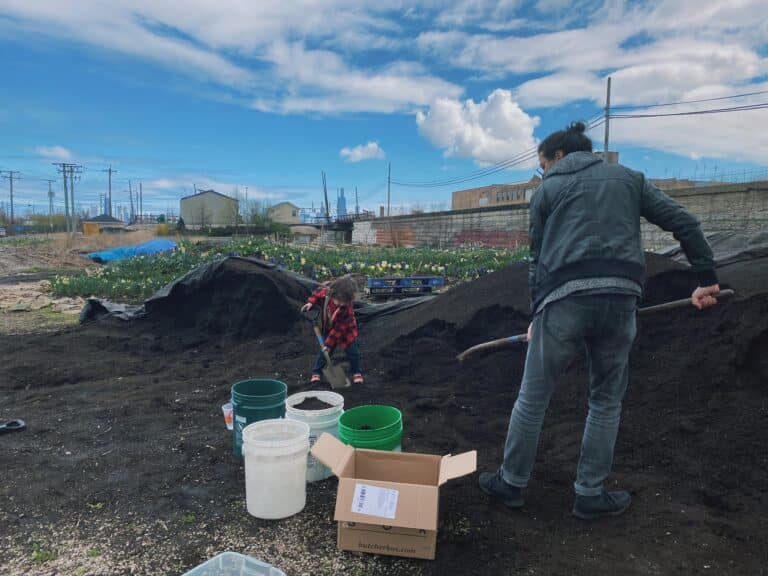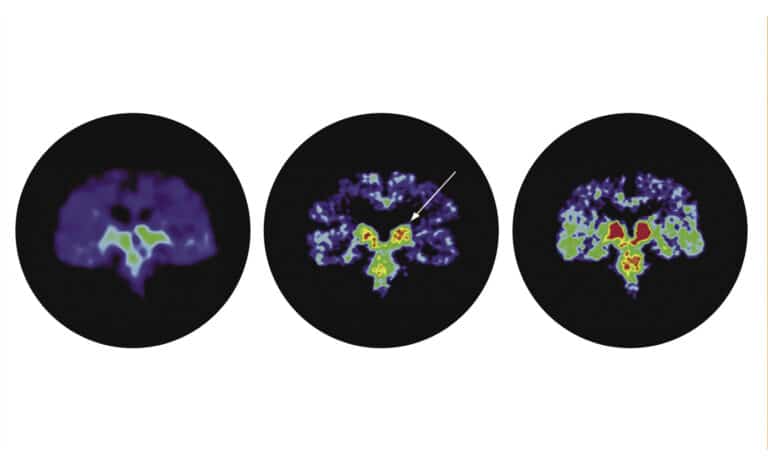How Chicago’s expanded composting program — and efforts throughout the city — cut waste and costs
Seeing your trash hauled away each week may feel like a relief — out of sight, out of mind.
But it shouldn’t be.
Once trash lands in a landfill, it doesn’t disappear. It continues to take up space, and discarded food, which makes up about one-quarter of landfills. Food scraps decompose without oxygen in landfills, creating methane far more quickly than they would through composting. This greenhouse gas traps heat in the atmosphere and contributes to global warming, directly affecting human health.
To combat this, many Chicagoans are turning to composting. The process lets food decompose naturally, producing nutrient-rich soil to grow healthy fruits and vegetables. Compost’s texture also helps it retain water, which plants need to thrive.
And today, the City of Chicago is enabling even more Chicagoans to get in on composting. Chicago Public Libraries and the Department of Streets and Sanitation announced a food scrap drop-off program at 13 new library locations, to keep food waste out of landfills.
“Diverting food waste from landfills to composting is one of the easiest and most impactful actions individuals and cities can take to fight climate change,” Chicago Mayor Brandon Johnson said via a press release. “This collaboration between CPL and DSS makes composting even more convenient for Chicago residents and builds on our shared vision of a cleaner, greener and healthier city.”
The city’s Food Scrap Drop-Off Program — free to Chicago residents — launched in October 2023. More than 7,400 households have diverted over 1 million pounds of food waste from landfills via 20 drop-off sites. But demand has grown in the past two years, and now some libraries are offering drop-off locations to make composting even more accessible.
New drop-off locations include:
- Avalon Branch – 8148 S. Stony Island Ave.
- Dunning Branch – 7455 W. Cornelia Ave.
- Edgebrook Branch – 5331 W. Devon Ave.
- Hegewisch Branch – 3048 E. 130th St.
- Lincoln Belmont Branch – 1659 W. Melrose St.
- Portage-Cragin Branch – 5108 W. Belmont Ave.
- Scottsdale Branch – 4101 W. 79th St.
- Sherman Park Branch – 5440 S. Racine Ave.
- Toman Branch – 2708 S. Pulaski Rd.
- Uptown Branch – 929 W. Buena Ave.
- Vodak-East Branch – 3710 E. 106th St.
- West Chicago Avenue Branch – 4856 W. Chicago Ave.
- Woodson Regional Library – 9525 S. Halsted St.
Individuals in Chicago aren’t the only ones composting. Businesses see the value, too.
Ian Hughes, director of environmental sustainability at Rush University Medical Center, says the hospital kitchen launched a composting program in 2022. By 2024, the program was collecting nearly 33,000 pounds of food waste.
Rush sends its food waste to Chicago’s Green Era, where a digester — a machine that mimics a cow’s stomach — breaks it down into compost. As the material decomposes, Green Era captures and cleans the methane to separate the renewable natural gas it contains. Green Era feeds the gas into the local energy grid, supplementing traditional power sources for Chicago homes and businesses.
Rush’s program also has had unexpected benefits. The data collected from food waste revealed that the hospital was producing more food than necessary, helping to identify opportunities for food waste avoidance.
Composting has had a positive effect on staff, too. “We did a survey that showed the small action of composting has had a positive impact on their climate anxiety,” Hughes says.
If you want to start composting at home, here are four options Chicago residents can use to divert their food scraps from landfills.
1. Chicago’s drop-off compost bins
The City of Chicago offers residents two free composting options. Chris Sauve, Department of Streets and Sanitation’s deputy commissioner of policy and sustainability, says residents can sign up to take household food scraps to one of multiple drop-off bins across the city. Most people drop off scraps about once a week. The food waste is hauled away and transformed into compost. Residents can sign up at chi.gov/composting, which includes a short instructional video.
2. Backyard composting
For those who prefer to compost at home, the city offers a backyard composting bin program. Since its launch in October 2024, Chicago has delivered approximately 3,172 bins to residents. Susan Casey, streets and sanitation program director of composting and food waste, says this do-it-yourself approach isn’t for everyone but has clear advantages.
“A great benefit is that you can compost both food scraps and yard waste,” Casey says. “The backyard bins connect people with nature and let them see the composting process with their very own eyes.” The process requires minimal effort — just adding scraps and turning them regularly to keep the mixture aerated. “They can use the compost in their own garden, which saves money.”
3. Indoor composting
For those who want to compost indoors, Nancy Kreith University of Illinois Extension horticulture educator, recommends worm composting. A 10-gallon opaque plastic bin with holes in the lid can house up to 1,000 worms.
Kreith kept one bin under her sink when she lived in an apartment and now maintains four bins in her basement for her family of four. “At the end of three months, you will have enough compost for starting seedlings or nourishing your potted plants,” she says.
4. Compost pickup
Chicagoans also can pay for private composting services, such as the Urban Canopy or WasteNot Compost. WasteNot began in 2015 when founder Liam Donnelly, then working at a café, started bringing the shop’s coffee grounds and food waste home to compost in his parents’ backyard. His boss found out and started paying him for the service.
Today, Donnelly is CEO of WasteNot Compost, which operates a fleet of 25 electric vehicles and serves more than 10,000 Chicago households. The company also partners with seven municipalities for compost collection. In 2024, WasteNot composted more than 6 million pounds of food waste from homes and businesses, according to the company’s growth manager, Tommy Vaughan.
WasteNot members fill 5-gallon buckets with compostables. Weekly or biweekly, the company swaps out full buckets for clean ones. Service plans for homes, apartments, and condos cost $12 for biweekly pickup and $10 for weekly service. Customers receive 20 pounds of free compost once a year or can donate their share to community gardens. Plans are also available for businesses.
When people compost, they often realize how much food they’re wasting and begin shopping more efficiently — as happened at Rush. The Environmental Protection Agency estimates that the average family of four could save $56 a week by reducing the amount of food they buy.
No matter which option you choose, Kreith says, “The real purpose is to keep food scraps out of the landfill.”

Nancy Maes, who studied and worked in France for 10 years, writes about health, cultural events, food and the healing power of the arts.










